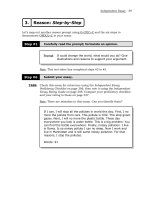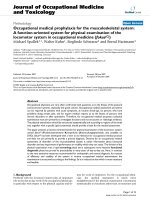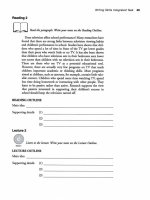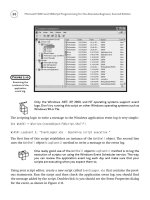Clinical Tests for the Musculoskeletal System - part 8 ppt
Bạn đang xem bản rút gọn của tài liệu. Xem và tải ngay bản đầy đủ của tài liệu tại đây (834.22 KB, 31 trang )
Paessler Rotational Compression Test
Procedure:
The patient is seated. The examiner immobilizes the foot of
the leg to be examined, holding it between his or her own legs slightly
proximal to the knees. To e valuate the medial meniscus, the examiner
190 Knee
a b
c d
Fig.
202a–d
Anderson medial and lateral compression test:
a
starting position,
b
valgus stress during flexion of the knee to 45°,
c
extension of the 45° flexed knee,
d
varus stress during extension of the knee
Buckup, Clinical Tests for the Musculoskeletal System © 2004 Thieme
All rights reserved. Usage subject to terms and conditions of license.
rests both thumbs on th e medial joint cav ity and moves the patient’s
knee in a circle in the form of external and internal rotational move-
ments. This causes the knee to move through various degrees of flexion.
At the same time, the examiner applies a varus or valgus stress, respec-
tively.
Assessment:
The test is positive when the patient reports pain with the
circular motion. It is considered strongly positive when pain can be
elicited by the circular motion alone in either the medial joint cavity
(suspected lateral meniscus lesion) or the lateral joint cavity (suspected
medial meniscus lesion).
Knee 191
a
b
Fig.
203a, b
Paessler rotational compression test:
a
starting position with examiner’s thumb on medial joint cavity,
b
circular motion of the knee
Buckup, Clinical Tests for the Musculoskeletal System © 2004 Thieme
All rights reserved. Usage subject to terms and conditions of license.
Tschaklin Sign
Quadriceps atrophy is often encountered in chronic meniscus lesions.
Atrophy of the vastus medialis in medial meniscus lesions is often
associated with compensatory increase in muscle tone in the sartorius,
which is known as the Tschaklin sign.
Wilson Test
Demonstrates osteochondritis dissecans on the medial femoral condyle.
Procedure:
The examiner grasps the patient’s knee proximal to the
patella with one hand, palpating the medial joint cavity.
Assessment:
In osteochondritis dissecans, compression due to joint
motion and the palpating finger will produce symptoms betwee n 20°
and 30° of flexion. These symptoms can then typically be reduced by
externally rotating the lower leg.
Note:
Osteochondritis dissecans is an aseptic necrosis that arises in the
subchondral bone of the articular surfaces and disrupts the overlying
cartilage. In its advanced stages, separation of part of the articular
cartilage and underlying bone can occur, creating an intraarticular loose
body. Osteochondritis dissecans should always be considered in ado-
lescents presenting with joint e ffusion and kn ee pain.
192 Knee
a b
Fig.
204a, b
Wilson test:
a
extension in internal rotation,
b
external rotation
Buckup, Clinical Tests for the Musculoskeletal System © 2004 Thieme
All rights reserved. Usage subject to terms and conditions of license.
˾
Knee Ligament Stability Tests
The knee is stabilized by the ligaments, menisci, the shape and congru-
ency of the articular surfaces, and the musculature. The ligaments
ensure functional congruency by guiding the femur and tibia a nd limit-
ing the space between them. Ligament injuries lead to functional im-
pairment of the knee with instability. Knee ligament stability tests can
help to identify and differentiate these instabilities.
Abnormal directions of motion can be divided into three categories:
1. Direct instability in a single plane
2. Rotational instability
3. Combined rotational instability
Clinical instability is divided into three degrees. Estimated joint opening
or drawer of up to 5 mm is defined as 1+ (or +), 5–10 mm as 2+ (++), and
over 10 mm as 3+ (or +++).
Abduction and Adduction Test (Valgus and Varus Stress Test)
Assesses medial and lateral knee stability.
Procedure:
The patient is supine. The examiner grasps the patient’s
knee at the tibial head with both hands while p alpating the joint cavity.
The examiner immobilizes the patient’s distal lower leg between his or
her own forearm and waist while applying a valgus and varus stress to
the knee. The fingers resting on the joint cavity can palpate any opening
of the joint.
Assessment:
Lateral stability is assessed in 20° of flexion and in full
extension. Full extension prevents lateral opening as long as the poste-
rior capsule and posterior cruciate ligament are intact, even if the
medial collateral ligament is torn. In 20° of flexion, the posterior capsule
is relaxed. Applying a valgus stress in this position evaluates the medial
collateral ligament alone as the primary stabilizer. This allows the
examiner to identify the nature of damage to the posteromedial capsu-
lar ligaments.
The opposite applies to adduction (varus) stress. In 20° of flexion, the
primary lateral stabilizer is the lateral collateral ligament. The anterior
cruciate ligament and pop liteus tendon act as secondary stabilizers.
When testing lateral stability, th e examiner assessed the degree of
joint opening and the quality of the endpoint.
Knee 193
Buckup, Clinical Tests for the Musculoskeletal System © 2004 Thieme
All rights reserved. Usage subject to terms and conditions of license.
˾
Function Tests to Assess the Anterior
Cruciate Ligament
Lachman Test
Procedure:
The patient is supine with the knee flexed 15°–30°. The
examiner holds the femur with one hand while pulling the tibia ante-
riorly with the other. The quadriceps and knee flexors must be com-
pletely relaxed.
Assessment:
The anterior cruciate ligament is damaged when mobility
of the tibia with respect to the femur can be demonstrated. The end-
194 Knee
a
b
Fig.
205a, b
Abduction
and adduction test:
a
valgus and varus stress
as the knee approaches
extension,
b
valgus and varus stress
in flexion
Buckup, Clinical Tests for the Musculoskeletal System © 2004 Thieme
All rights reserved. Usage subject to terms and conditions of license.
point of motion must be soft and gradual without a hard stop; any hard
stop suggests a certain stability of the anterior cruciate ligament. A hard
endpoint within 3 mm suggests complete stability of the anterior cru-
ciate, whereas one after 5 mm or more suggests relative stability of the
anterior cruciate ligament, such as may be present following an earlier
sprain.
Cruciate ligament injury should be suspected where the endpoint is
soft or absent. In the presence of a drawer exceedin g 5 mm, comparison
with the contralateral knee is helpful in excluding congenital laxity of
the articular ligaments.
A positive Lachman test is certain proof of anterior cruciate ligament
insuf• ciency.
Knee 195
a
b
Fig.
206a, b
Lachman test:
a
starting position,
b
anterior drawer
Buckup, Clinical Tests for the Musculoskeletal System © 2004 Thieme
All rights reserved. Usage subject to terms and conditions of license.
Prone Lachman Test
Procedure:
The patient is prone. The examiner grasps the l a teral
aspect o f the proximal tibia and immobilizes the patient’s leg in his or
her own axilla. With the other hand, the ex aminer grasps the distal
femur immediately proximal to the patella to immobilize the thigh.
Then the examiner pushes the tibia anteriorly with respect to the femur.
Assessment:
Identical to the Lachman test (see p. 194).
Note:
Although the patient is relaxed in the prone position, it is not
always easy to assess the quality of the endpoint. A hard endpoint and
hemarthrosis suggest an acute partial tear; a hard endpoint without
hemarthrosis suggests a suspected chronic partial tear, elongation, or
excessive laxity.
A soft endpoint and hemarthrosis suggest a complete te ar; a soft
endpoint without hemarthrosis suggests a chronic complete tear.
Where the endpoint is har d, a posterior cruciate lesion must be ex-
cluded by testing the sp ontaneous posterior d rawer and ap plying the
active tests.
Stable Lachman Test
A variation of the classic Lachman test.
Procedure:
The patient is supine. The examiner places the patient’s
thigh over his or her own thigh. This holds the patient’s leg in constant
196 Knee
Fig.
207
Prone Lachman test
Buckup, Clinical Tests for the Musculoskeletal System © 2004 Thieme
All rights reserved. Usage subject to terms and conditions of license.
flexion that the patient cannot change. With the distal hand, the exam-
iner pulls the tibia anteriorly while the other hand immobilizes the
patient’s thigh on the examiner’s own thigh.
Assessment:
Identical to the classic Lachman test.
Note:
The classic Lach man test not only presents problems for exam -
iners with small hands; simultaneously immobilizing the thigh an d
lower leg can be also dif• cult for any examiner with an obese or
muscular patient. Using one’s own thigh as a “work bench” for examin-
ing the patient’s knee is an easy solution in such cases and one that
allows examination even of obese or muscular patients. The character of
the endpoint (hard or soft) is easier to evaluate in this test.
No-Touch Lachman Test
Procedure:
The patient is supine and grasps the thigh of the affected
leg near the knee with both hands and slightly flexes the knee. The
patient is then asked to raise the lower leg off the examining table while
maintaining flexion i n the knee. The examiner observes the position of
the tibial tuberosity during this maneuver.
Assessment:
If the ligaments are intact, there will be no change in
contour, or only a slight one as the tibial tuberosity moves slightly
anteriorly. In an acute injury to the capsular ligaments involving the
anterior cruciate and medial collateral ligaments, the examiner will
observe a significant anterior displacement of the tibial tuberosity (sub-
luxation of the joint).
Knee 197
Fig.
208
Stable Lachman test
Buckup, Clinical Tests for the Musculoskeletal System © 2004 Thieme
All rights reserved. Usage subject to terms and conditions of license.
Note:
This test often allows one to exclude complex injuries without
having to touch the patient.
Active Lachman Test
Procedure:
The examiner asks the supine patient to extend the leg in
such as way as to lift the foot off the examining table. During this
maneuver, the examiner keeps his or her eyes on the knee the better
to discern the contours of the tibial tuberosity and patellar ligament. The
examiner achieves slight passive flexion in the knee by passing one
hand beneath the thigh of the patient’s affected leg and resting it on the
contralateral knee. The effect of the quadriceps is increased by immo-
bilizing the foot on the examining table.
Assessment:
Slight migration of the tibial head will be observed where
the anterior cruciate ligament i s intact. In a cruciate tear, there will be a
significant anterior migration compared with the contralateral side. This
is because the anterior cruciate l igament no longer limits the displace-
ment caused by c on traction of the quadriceps.
Note:
The physiologic drawer in active motion as the knee ap proaches
extension usually measures 2–3 mm. In contrast, tibial displacement of
3–6 mm will be observed with an anterior cruciate ligament tear. This
test should only be performed after excluding a posterior cruciate
ligament injury, in which the tibia would spontaneously displace pos-
198 Knee
Fig.
209
No-touch Lachman test
Buckup, Clinical Tests for the Musculoskeletal System © 2004 Thieme
All rights reserved. Usage subject to terms and conditions of license.
teriorly. There, too, contraction of the quadriceps will produce signifi-
cant anterior displacement of the tibia and with it a false-positive active
anterior drawer test.
Contraction of the quadriceps can also cause meniscal impingement
where loosening of the p osterior attachment of the medial meniscus
accompanies the insuf• ciency of the medial ligaments and anterior
cruciate.
The active Lachman te st differs from the traditional Lachman test in
that the lower leg can easily be immobilized in various degrees of
rotation and the stabilizing effect of the medial and lateral capsular
ligaments can be assessed. Generalized anterior instability (involving
the anterior cruciate ligament and the medial, posteromedial, lateral,
and posterolateral capsular ligaments) will produce significant active
anterior tibial di splacement in internal and neutral rotation and, espe-
cially, in external rotation.
Anterior Drawer Test in 90° Flexion
Passive anterior drawer test to assess the stability of the anterior cru-
ciate ligament.
Procedure:
The patient is supine with the hip flexed 45° and the knee
flexed 90°. The examiner sits on the edge of the examining table and
uses his or her buttocks to immobilize the patient’s foot in the desired
rotational position. The examiner then grasps the tibial head with both
hands and pulls it anteriorly with the patient’s knee flexors relaxed. The
test is performed in a neutral position, with the foot in 15° of external
rotation to assess anterior and medial instability, and with the foot in
30° of internal rotation to assess anterior and lateral instability.
Knee 199
Fig.
210
Active L achman test
Buckup, Clinical Tests for the Musculoskeletal System © 2004 Thieme
All rights reserved. Usage subject to terms and conditions of license.
Assessment:
A visible and palpable anterior d rawer (that is, anterior
displacement of the tibia with a soft endpoint) is present in chronic
insuf• ciency of the anterior cruciate ligament.
The anterior drawer test in 90 ° o f flexion is often negative in acute
injuries because pain often pr events the patient from achieving this
degree of flexion and causes reflexive muscle contraction. Additionally,
these are usually combined injuries involving complete or partial liga-
ment tears so that the stress of the drawer test stretches the partially
torn medial and l ateral structures. The resulting pain produces false-
negative test results, giving the appearance of a stable joint.
In acute injuries in particular, the test should preferably be per-
formed with the knee in slight flexion (Lachman test). The situation is
200 Knee
a
b
Fig.
211a, b
Anterior drawer test in 90° flexion:
a
starting position in external rotation,
b
anterior traction on the tibia
Buckup, Clinical Tests for the Musculoskeletal System © 2004 Thieme
All rights reserved. Usage subject to terms and conditions of license.
different in chronic ligament injuries, where the primary symptom is
the sensation of instability. In these cases, the test can usually be
performed painlessly in 90° of flexion and still provide useful diagnostic
information.
Note:
As a rule, the anterior drawer is best assessed in neutral rotation.
This allows one to demonstrate the greatest degree of displacement.
Rotation forces the tibia into a position where the twisting of the
peripheral ligaments and capsular structures increases tension in the
joint, im pairing the mobility of the drawer. Assessment of rotational
stability together with assessment of lateral stability in flexion and
extension provides information about the complexity of the ligament
injury and the stability of the secondary stabilizers.
An anterior drawer should not automatically be interpreted as an
anterior cruciate ligament tear. On the other hand, a negative drawer
test does not necessarily confirm that the anterior cruciate is intact. The
proximal portion of the tibia is pulled anteriorly or pushed posteriorly. It
can be dif• cult to determine the exact starting position (the neutral
position) from which an anteriorly directed force will produce an ante-
rior drawer. For example, where the examiner exerts an anterior drawer
stress in the presence of a posterior cruciate ligament injury in which
the tibial head is posteriorly depressed (a spontaneous posterior
drawer), it will seem as if an isolated anterior drawer wer e presen t.
What has actually happened in this case is that the tibia has merely been
drawn anteriorly out of its posterior di splacement (due to the posterior
cruciate tear) and into a neutral position. The anterior cruciate then
tenses and limits further anterior displacement of the tibia.
Caution:
An apparent anterior drawer may only be interpreted as a
true anterior drawer once the absence of a posterior drawer has been
demonstrated.
Jakob Maximum Drawer Test
Procedure:
The patient is supine with the knee flexed 50°–60°. The
examiner pushes the tibial head into maximum anterior subluxation
with his or he r forearm while grasping the patient’s contralateral knee
with the hand of the same arm. With the other hand, the examiner
grasps the tibial head and palpates how far anteriorly the medial or
lateral joint cavity is displaced. The patient’s lower leg is not immobi-
lized in this test so that rotation is not restricted. This allows maximum
tibial displacement.
Assessment:
See anterior drawer test in 90° flexion.
Knee 201
Buckup, Clinical Tests for the Musculoskeletal System © 2004 Thieme
All rights reserved. Usage subject to terms and conditions of license.
different in chronic ligament injuries, where the primary symptom is
the sensation of instability. In these cases, the test can usually be
performed painlessly in 90° of flexion and still provide useful diagnostic
information.
Note:
As a rule, the anterior drawer is best assessed in neutral rotation.
This allows one to demonstrate the greatest degree of displacement.
Rotation forces the tibia into a position where the twisting of the
peripheral ligaments and capsular structures increases tension in the
joint, im pairing the mobility of the drawer. Assessment of rotational
stability together with assessment of lateral stability in flexion and
extension provides information about the complexity of the ligament
injury and the stability of the secondary stabilizers.
An anterior drawer should not automatically be interpreted as an
anterior cruciate ligament tear. On the other hand, a negative drawer
test does not necessarily confirm that the anterior cruciate is intact. The
proximal portion of the tibia is pulled anteriorly or pushed posteriorly. It
can be dif• cult to determine the exact starting position (the neutral
position) from which an anteriorly directed force will produce an ante-
rior drawer. For example, where the examiner exerts an anterior drawer
stress in the presence of a posterior cruciate ligament injury in which
the tibial head is posteriorly depressed (a spontaneous posterior
drawer), it will seem as if an isolated anterior drawer wer e presen t.
What has actually happened in this case is that the tibia has merely been
drawn anteriorly out of its posterior di splacement (due to the posterior
cruciate tear) and into a neutral position. The anterior cruciate then
tenses and limits further anterior displacement of the tibia.
Caution:
An apparent anterior drawer may only be interpreted as a
true anterior drawer once the absence of a posterior drawer has been
demonstrated.
Jakob Maximum Drawer Test
Procedure:
The patient is supine with the knee flexed 50°–60°. The
examiner pushes the tibial head into maximum anterior subluxation
with his or he r forearm while grasping the patient’s contralateral knee
with the hand of the same arm. With the other hand, the examiner
grasps the tibial head and palpates how far anteriorly the medial or
lateral joint cavity is displaced. The patient’s lower leg is not immobi-
lized in this test so that rotation is not restricted. This allows maximum
tibial displacement.
Assessment:
See anterior drawer test in 90° flexion.
Knee 201
Buckup, Clinical Tests for the Musculoskeletal System © 2004 Thieme
All rights reserved. Usage subject to terms and conditions of license.
Pivot Shift Test
Procedure:
The patient is supine. The examiner grasps and immobil-
izes the lateral femoral condyle with one hand and palpates the prox-
imal tibia or fibula with the thumb. With the other hand, the examiner
holds the patient’s lower leg in internal rotation and abduction (valgus
stress). From this starting position the knee is then moved from exten-
sion into flexion.
202 Knee
a
b
Fig.
212a, b
Jakob maximum drawer test:
a
starting position,
b
maximum anterior traction on the tibia
Buckup, Clinical Tests for the Musculoskeletal System © 2004 Thieme
All rights reserved. Usage subject to terms and conditions of license.
Assessment:
In the presence of a torn anterior cruciate ligament, the
valgus stress will cause the tibia to subluxate anteriorly while the knee
is still in extension. The blockade of the knee in anterior subluxation
depends on the degree of valgus stress applied; occasionally the sign can
be elicited more easily when the examiner immobilizes the patient’s leg
between his or her own fore arm and waist while applying slight axial
compression. The knee is then flexed while the same internal rotation
and abduction of the lower leg is maintained; this then causes the
subluxated tibial head to reduce posteriorly at 20°–40° of flexion. The
iliotibial tract, which with increasing flexion glides from a position
Knee 203
a
b
Fig.
213a, b
Pivot shift test:
a
starting position: internal rotation
and abduction, valgus stress;
b
flexion
Buckup, Clinical Tests for the Musculoskeletal System © 2004 Thieme
All rights reserved. Usage subject to terms and conditions of license.
anterior to the lateral epicondyle in extension to a position posterior to
the axis of flexion, draws the tibial head posteriorly again. The degree of
reduction and flexion depends on the severity of the anterior sublux-
ation. Reduction occurs earlier when there is only slight anterior trans-
lation. The patient usually confirms the diagnosis by reporting that the
typical sensation of the knee giving way felt in sports activities can be
reproduced i n this test.
According to Jakob, a genuine pivot shift phenomenon can partially
disappear, despite anterior cruciate ligament insuf• ciency, under the
following conditions:
1. When a complete tear of the medi al collateral ligament is present,
the valgus opening prevents force concentration in the lateral com-
partment. Subluxation cannot occur un der these circumstances.
2. When the iliotibial tract is traumatically divided, o nly the subluxa-
tion will be observed, not the abrupt re duction.
3. A bucket handle tear of the medial or lateral meniscus can prevent
anterior translation or reduction of the tibia.
4. Increasing osteoarthritis in the lateral compartment with osteo-
phytes can create a concave contour along the once convex lateral
tibial plateau.
Jakob Graded Pivot Shift Test
Gradation of the pivot shift test all owing for translation and rotation of
the tibia.
Procedure:
The procedure is identical to the pivot shift test except that
here instability of the knee is assessed with the lower leg in not only
internal ro tation, but in neutral and external rotation as well.
Assessment:
Pivot shift grade I: The pivot shift test is positive only in
maximum internal rotation; i t is negative in neutral and internal rota-
tion. The subluxation as the knee approaches extension is more palpable
than visible to the examiner (slight tran slation may be apparent).
Pivot shift grade II: The pivot shift test is positive in internal and
neutral rotation; however, it is negative in external rotation. There is
visible and palpable translation on the lateral aspect of the joint.
Pivot shift grade III: The pivot shift test is clearly p ositive in neutral
rotation and particularly conspicuous in external rotation. The sign is
less distinct in internal rotation.
Pivot shift grade IV can only be demonstrated in acute knee injuries
where the posteromedial and lateral structures are damaged in addition
to the anterior cruciate. In chr onic instability, a grade III pivot shift will
204 Knee
Buckup, Clinical Tests for the Musculoskeletal System © 2004 Thieme
All rights reserved. Usage subject to terms and conditions of license.
Knee 205
a
b
Fig.
214a, b
Jakob graded p ivot shift test:
a
starting position: flexion and internal rotation of lower leg, valgus stress on
the knee;
b
anterior subluxation of the lateral tibial head as the knee approaches exten-
sion with lower leg internally rotated and valgus stress on the knee
Buckup, Clinical Tests for the Musculoskeletal System © 2004 Thieme
All rights reserved. Usage subject to terms and conditions of license.
be detectable in cases where the secondary stabilizers have loosened
over time.
Note:
In an anterior cruciate tear, both the medial and lateral portions
of the tibia migrate anteriorly under the stress of the anterior draw e r.
In an isolated tear of the an terior cruciate ligament, the anterior
motion of the lateral portion of the tibia will be more pronounced
than that of the medial portion. The anterior motion of the medial
portion of the tibial plateau incre ases relative to that of the lateral
portion as the number of injured medial structures increases. Increasing
anterior motion of the medial tibial plateau in turn increases the se-
verity of the subluxation and subsequent reduction phenomenon ob-
served by the examiner. This reduction will also be observed to occur at
an increasingly high degree of flexion.
Modified Pivot Shift Test
Procedure:
The patient is sup ine. With one hand, the examiner ho l ds
the patient’s lower leg in internal rotation while the other hand grasp s
the tibial he a d laterally and holds it in a valgus position. In a positive
test, this alone will produce anterior subluxation of the lateral tibial
head. The rest of the procedure is identical to the pivot shift test.
Subsequently flexing the knee while maintaining internal rotation and
valgus stress on the lower leg causes posterior reduction of the sub-
luxated tibial head at about 30° of flexion. The test is performed with th e
femoral head in abduction and adduction and in each case with the
lower leg in external and internal rotation.
Assessment:
The iliotibial tract plays an important role in subluxation
as the knee approaches extension and in subsequent red uction as
flexion increases in the pivot shift test. The initial stress present in the
iliotibial tract greatly influences the severity of subluxation. The ilioti-
bial tract is relaxed in hip abduction, whe reas it is under tension in hip
adduction.
The iliotibial tract contributes directly an d indirectly (passively) to
stabilizing the lateral knee. The portion of the iliotibial tract between the
fibers of Kaplan and Gerdy's tub ercle can be regarded as a passive
ligament-like structure that is placed under tension by the proximal
portion of the tract that courses through the thigh. The tension in this
passive femorotibial portion of the tract determines the degree of sub-
luxation of the tibial head. Internally rotating the lower leg and adduct-
ing the hip tenses the entire iliotibial tract, which increases tension in
the ligament-like portion that spans the knee. Th i s tension will prevent
206 Knee
Buckup, Clinical Tests for the Musculoskeletal System © 2004 Thieme
All rights reserved. Usage subject to terms and conditions of license.
anterior subluxation of the tibial head during the pivot shift test in the
presence of a torn anterior cruciate ligament. However, externally ro-
tating the lower leg reduces the tension in the portion of the iliotibial
tract that spans the knee, allowing greater anterior subluxation of the
tibial head. The degree of subluxation is even greater when the leg is
abducted.
Knee 207
a b
c d
Fig.
215a–d
Modified pivot shift test:
a
subluxation during e xtension of the adducted leg with valgus stress and lower
leg internally rotated,
b
reduction during flexion of the leg from the same position,
c
subluxation during extension of the abducted leg with valgus stress on the
knee and lower leg externally rotated,
d
reduction during flexion of the leg from the same position
Buckup, Clinical Tests for the Musculoskeletal System © 2004 Thieme
All rights reserved. Usage subject to terms and conditions of license.
Medial Shift Test
Procedure:
The examiner immobilizes the patient’s lower leg between
his or her forearm and waist to evaluate the medial or lateral translation
(tibial displacement) as the knee approaches extension. To assess me-
dial translation, the examiner places one han d on the lower leg slightly
distal to the medial joint cavity while the other hand rests on the lateral
thigh. While applying a valgus stress t o the knee via the lower leg, the
examiner presses medially with the hand resting on the p a tient’s thigh.
Assessment:
In an anterior cruciate tear, the tibia can be displaced
medially until the intercondylar eminence comes in contact with the
medial femoral condyle. Because the posterior cruciate ligament courses
from medial to la teral, lateral translation of the tibial head will be
detectable in the presence of a po sterior cruciate tear (positive lateral
shift test).
Soft Pivot Shift Test
Procedure:
The patient is supine. The examiner grasps the patient’s
foot with one hand and the calf with the other. First, the examiner
alternately flexes and extends the knee carefully, using these normal
everyday motion sequences to alleviate the patient’s anxiety and reduce
208 Knee
Fig.
216
Medial shift test
Buckup, Clinical Tests for the Musculoskeletal System © 2004 Thieme
All rights reserved. Usage subject to terms and conditions of license.
reflexive muscle tension. The patient’s hip is abducted, and the foot is
held in neutral or external rotation.
Next, the examiner gently applies axial compression after about 3–5
flexion and extension cycles. With the hand resting on the calf, the
examiner applies a mild an terior stress.
Assessment:
Under axial compression and mild anterior stress, slight
subluxation will occur as the knee approaches extension, with reduction
occurring as flexion increases. By varying the speed of the flexion and
extension cycle, the axial compression, and anteriorly d i rected pressure,
the examiner can precisely control the intensity of the subluxation and
subsequent reduction. In this t est, the examiner literally feels his or her
way toward the subluxation and reduction.
Note:
The soft pivot shift test ensures reduction with minimal pain o r
even with no pain at all. Carefully performed, this test can be repeated
several times without the patient's complaining of pain.
Knee 209
a
b
Fig.
217a, b
Soft pivot shift
test:
a
subluxation as the knee
approaches extension with the
lower leg externally rotated
while applying axial compres-
sion and anterior stress,
b
reduction in flexion while
maintaining th e axial com-
pression and applying slight
valgus stress
Buckup, Clinical Tests for the Musculoskeletal System © 2004 Thieme
All rights reserved. Usage subject to terms and conditions of license.
Martens Test
Procedure:
The patient is supine. The examiner stands lateral to the
injured leg and immobilizes the patient’s calf distal to the knee with one
hand, resting the index finger on the fibula. The patient’s lower leg is
immobilized between the examiner’s forearm and waist while a valgus
stress is applied. While pulling the lower leg anteriorly with one hand,
the examiner pushes the distal thigh posteriorly with the other.
Assessment:
The maneuver begins with the knee in a position ap-
proaching extension. As flexion is increased from this starting position,
the subluxated lateral po r tion of the tibia will reduce at about 30° of
flexion if an anterior cruciate ligament i njury is present.
Losee Test
Procedure:
The patient is supine. The examiner grasps the knee later-
ally with the thumb posterior to the fibular head and the fingers r esting
on the patella. The other hand grasps the lower leg medially proximal to
the ankle. In contrast to the other dynamic subluxation tests, the exam -
iner does not internally rotate the lower leg but instead moves it into
slight external rotation.
210 Knee
Fig.
218
Martens test
Buckup, Clinical Tests for the Musculoskeletal System © 2004 Thieme
All rights reserved. Usage subject to terms and conditions of license.
Assessment:
When the knee is extended from 40°–50° of flexion, an
anterior cruciate ligament injury will l ead to visible and palpable ante-
rior subluxation of the lateral portion of the tibial head.
Note:
Traditionally, the external rotation of the lower leg has marked
out the Losee test among the dynamic subluxation tests. Ho wever, it is
important for the examiner not to force this external rotation, but to
hold the lower leg in a relaxed way in external rotation with the knee
flexed. Extending the knee causes the lateral portion of the tibia to
subluxate anteriorly, meaning that the entire lower leg moves into
internal rotation. The e xa miner must not interfere with this relative
internal rotation.
Slocum Test
Procedure:
The patient lies on the unaffected side with the hip and
knee flexed, holding the injured upper leg in slight internal rotation
with the foot extended where possible. In this position, the weig ht of
the leg exerts a slight valgus stress. The examiner stands behind the
patient and grasps the pa tient’s thigh with one han d, palpating the
fibular head with the thumb or index finger.
Assessment:
In an injury to the anterior cruciate ligament, the lateral
tibial head will subluxate anteriorly with the knee in a position ap-
proaching extension. Subsequent flexion will then lead to posterior
reduction of the tibial head at about 30° of flexion.
Knee 211
Fig.
219
Losee test Fig.
220
Slocum test
Buckup, Clinical Tests for the Musculoskeletal System © 2004 Thieme
All rights reserved. Usage subject to terms and conditions of license.
Arnold Crossover Test
Procedure:
The examiner immobilizes the foot of the patient’s injured
leg. The patient then crosses the normal leg over the injured leg, rotat-
ing the pelvis and trunk toward the injured side.
Assessment:
The contraction of the quadriceps causes the immobilized
leg to reproduce the lateral pivot shift phenomenon. The patient will
experience an unpleasant sensation and report that the knee is abo ut to
dislocate.
Note:
In muscular patients, this test usually provides more useful
diagnostic information than the other dynamic anterior cruciate liga-
ment tests.
Noyes Test
Procedure:
The patient is supine. The examiner grasps the tibial head
with both hands and immobilizes the patient’s distal lower leg between
his or her forearm and waist. With the knee in about 20° of flexion, the
212 Knee
a b
Fig.
221a, b
Arnold crossover test:
a
starting position,
b
crossover
Buckup, Clinical Tests for the Musculoskeletal System © 2004 Thieme
All rights reserved. Usage subject to terms and conditions of license.
examiner elicits a slight anterior drawer motion while simultaneously
using the index fingers to evaluate whether the hamstrings are relaxed.
The distal femur will drop into external rotation and slightly recede
posteriorly (subluxation). The knee is then flexed from this position.
Assessment:
In contrast to other dynamic anterior subluxation tests, it
is not the lateral portion of the tibia but the distal femur that is tested for
reduction and subluxation relative to the tibial head, which the ex am-
iner immobilizes and guides posteriorly. The test is positive when knee
flexion results in palpable internal rotation of the distal femur (reduc-
tion). This indicates cruciate ligament insuf• ciency.
Note:
The Noyes test is suitable for assessing cruciate ligament insuf-
ficiency in an apprehensive patient who has dif• culty relaxing the
hamstrings.
Jakob Giving Way Test
Procedure:
The patient leans against the wall on the normal side and
distributes his or her body weight over both legs. T he examiner places
one hand each proximal and distal to the injured knee and applies a
valgus stress while the patient flexes the knee.
Knee 213
Gig.
222
Noyes test
Buckup, Clinical Tests for the Musculoskeletal System © 2004 Thieme
All rights reserved. Usage subject to terms and conditions of license.









